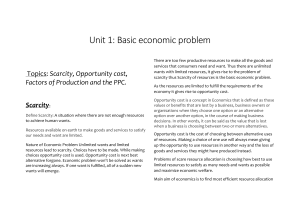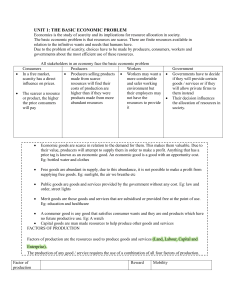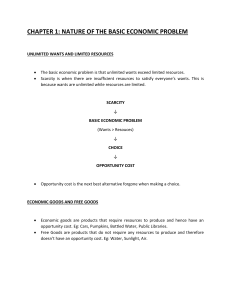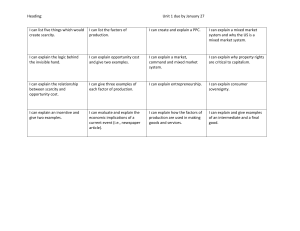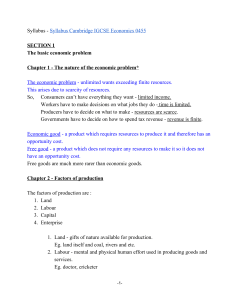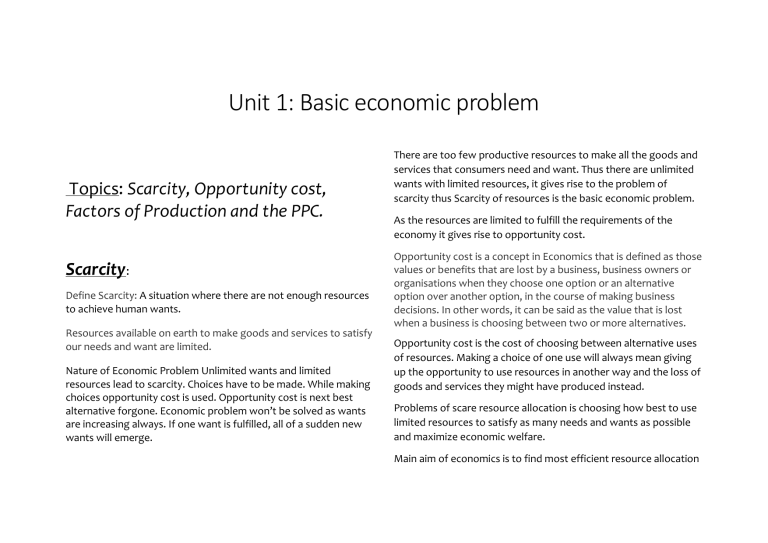
Unit 1: Basic economic problem Topics: Scarcity, Opportunity cost, Factors of Production and the PPC. Scarcity: Define Scarcity: A situation where there are not enough resources to achieve human wants. Resources available on earth to make goods and services to satisfy our needs and want are limited. Nature of Economic Problem Unlimited wants and limited resources lead to scarcity. Choices have to be made. While making choices opportunity cost is used. Opportunity cost is next best alternative forgone. Economic problem won’t be solved as wants are increasing always. If one want is fulfilled, all of a sudden new wants will emerge. There are too few productive resources to make all the goods and services that consumers need and want. Thus there are unlimited wants with limited resources, it gives rise to the problem of scarcity thus Scarcity of resources is the basic economic problem. As the resources are limited to fulfill the requirements of the economy it gives rise to opportunity cost. Opportunity cost is a concept in Economics that is defined as those values or benefits that are lost by a business, business owners or organisations when they choose one option or an alternative option over another option, in the course of making business decisions. In other words, it can be said as the value that is lost when a business is choosing between two or more alternatives. Opportunity cost is the cost of choosing between alternative uses of resources. Making a choice of one use will always mean giving up the opportunity to use resources in another way and the loss of goods and services they might have produced instead. Problems of scare resource allocation is choosing how best to use limited resources to satisfy as many needs and wants as possible and maximize economic welfare. Main aim of economics is to find most efficient resource allocation Definition of opportunity cost: Opportunity cost is the next best alternative forgone Opportunity costs can be calculated using the following formula: “Opportunity Cost = Return on investment for an option not chosen – Return on investment for a chosen option” The following are the limitations of opportunity costs: 1. Future returns cannot be predicted accurately using opportunity costs. 2. It is difficult to make quantitative comparison between two available alternatives. Example: 1.A city decides to build a hospital on vacant land it owns but it could have built a school or sports center. The opportunity cost is the value of the benefits forgone of the next best thing which could have been done. A land it owns Example 2: At the ice cream parlor you have to choose between butterscotch and strawberry. When you choose strawberry the opportunity cost is the enjoyment of butterscotch. Example 3: If you decide not to go to work, the opportunity cost is the loss of wages. Factors of Production (L.L.C.E) Factors of production have been categorized into four types: 1. Land 3. Recreation 4. Cultivation It refers to all natural resources. All natural resources either on the surface of the earth or below the surface of the earth or above the surface of the earth is Land. One uses the land to produces goods. It is the primary and natural factor of production. All gifts of nature such as rivers, oceans, land, climate, mountains, mines, forests etc. are land. The payment for land is rent. Characteristics of Land as a Factor of Production The land is a free gift of nature. The land has no cost of production. It is immobile. The land is fixed and limited in supply. Types of Land 1. Residential 2. Commercial 5. Extraction 6. Uninhabitable 3. Capital 2. Labour All human effort that assists in production is labour. This effort can be mental or physical. It is a human factor of production. It is the worker who applies their efforts, abilities, and skills to produce. Capital refers to all manmade resources used in the production process. It is a produced factor of production. It includes factories, machinery, tools, equipment, raw materials, wealth etc. The payment for labour is the wage. The payment for capital is interest. Characteristic Characteristics It is a human factor. Capital is a manmade factor of production. One cannot store labour. It is mobile. No two types of labour are the same. It is a passive factor of production. Types of Labour Types of Capital 1 Unskilled 1. Fixed 2 Semi-skilled 2. Working 3 Skilled 3. Venture 4 Professional 5. Entrepreneur An entrepreneur is a person who brings other factors of production in one place. He uses them for the production process. He is the person who decides What to produce Where to produce How to produce A person who takes these decisions along with the associated risk is an entrepreneur. The payment for land is profit. Characteristics He has imagination. He has great administrative power. An entrepreneur must be a man of action. An entrepreneur must have the ability to organize. He should be a knowledgeable person. FOP Payment Definition Examples Geographical mobility Occupational mobility Land Rent All natural resources used in production. It include what’s on the surface, below and above the surface River water used in Production Mere Land Geographically Immobile Some land Occupationally mobile All human resources both mental and Physical used in production Workers, All man made goods used in production Machines, tools and building Labour Capital Wage/ Salary Interest E. g. can built houses or mall Raw materials Geographically mobile Managers Some land Occupationally immobile Some are geographically immobile if they are having family ties and health issues Some are occupationally Building- geographically immobile Some are occupationally mobile. E.g. building can be used to make notebooks or pencils Immobile if they are not having required skill and qualification Other capital geographically mobile Enterprise Profit Risk bearing and decision making factor of production Idea of the entrepreneur PRODUCTION POSSIBILITY CURVE Most mobile factor Most mobile factor A production possibility curve also known as the (PPC) is made to evaluate the performance of a manufacturing system when two commodities are manufactured together. diverts its resources to produce commodity B, the production of commodity A reduces. A point above the curve indicates the unattainable with the available resources. A point below the curve means that the production is not utilising 100 percent of the business’ resources. The PPC helps to plan the perfect proportion of goods to produce in order to reduce the wastage and costs while maximising profits. The diagram or graph explains the units of goods that a company can produce if all the resources are utilised productively. Therefore, a single commodity’s maximum manufacturing probability is arranged on the X-axis and that of the other commodity on the Y-axis. Here, the curve is represented to show the number of products that can be created with limited resources, while pausing the use of technology in between. In the graph, the line sloping down also depicts the trade-off between producing commodity A and commodity B. When a firm The production of 20,000 watermelons and 1,20,000 pineapples is shown on point B in the graph. If the production of watermelons needs to be more, then the production of pineapples should be less. On the graph, point C indicates that if the production of watermelons has to be 45,000, then the company can deliver only 85,000 pineapples. With this trade-off, the curve shows the idea of opportunity cost. The production possibility curve also shows the choice of society between two different products The shape of the PPC curve is downward sloping and concave to the point of origin. The PPC curve is downward sloping because of the few units we sacrifice for the others as there exists an inverse relationship between the change in quantity of one commodity and the change in quantity of the other commodities.
